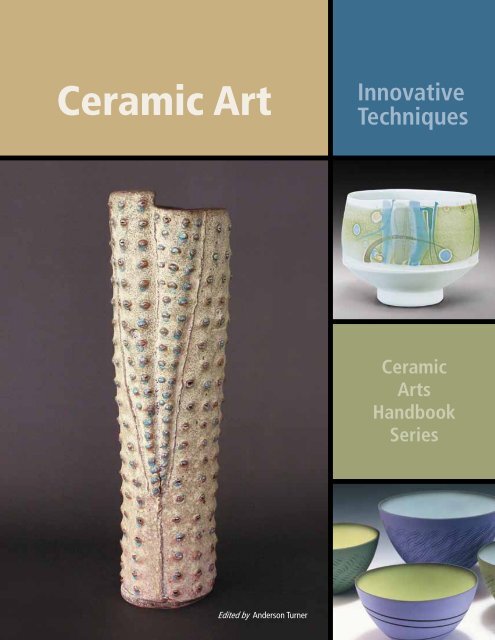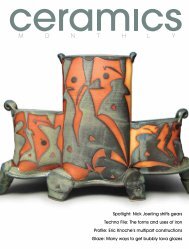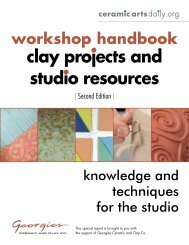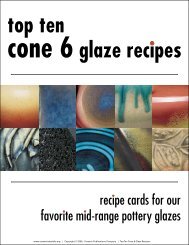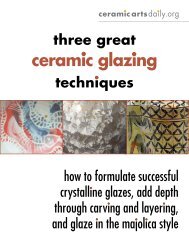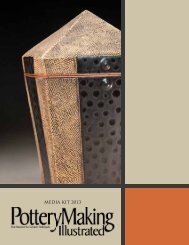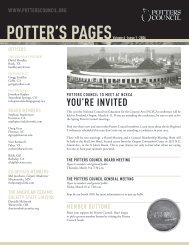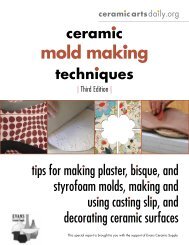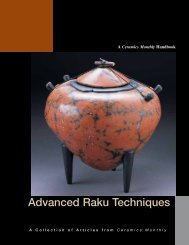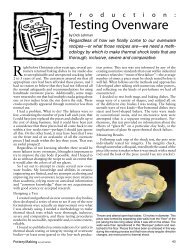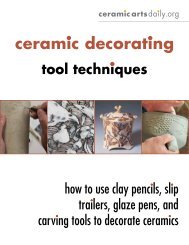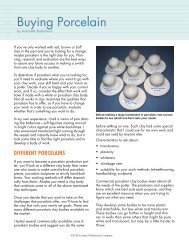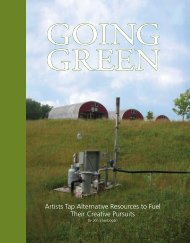Ceramic Arts Daily
Ceramic Arts Daily
Ceramic Arts Daily
Create successful ePaper yourself
Turn your PDF publications into a flip-book with our unique Google optimized e-Paper software.
<strong>Ceramic</strong> Art<br />
Edited by Anderson Turner<br />
Innovative<br />
Techniques<br />
<strong>Ceramic</strong><br />
<strong>Arts</strong><br />
Handbook<br />
Series
<strong>Ceramic</strong> Art<br />
i
Edited by Anderson Turner<br />
The American <strong>Ceramic</strong> Society<br />
600 N. Cleveland Ave., Suite 210<br />
Westerville, Ohio 43082<br />
www.<strong>Ceramic</strong><strong>Arts</strong><strong>Daily</strong>.org<br />
<strong>Ceramic</strong> Art<br />
Innovative<br />
Techniques<br />
<strong>Ceramic</strong><br />
<strong>Arts</strong><br />
Handbook<br />
Series
<strong>Ceramic</strong> <strong>Arts</strong> Handbook<br />
iv<br />
The American <strong>Ceramic</strong> Society<br />
600 N. Cleveland Ave., Suite 210<br />
Westerville, OH 43082<br />
© 2009, 2011 by The American <strong>Ceramic</strong> Society, All rights reserved.<br />
ISBN: 978-1-57498-299-2 (Paperback)<br />
ISBN: 978-1-57498-529-0 (PDF)<br />
No part of this book may be reproduced, stored in a retrieval system or transmitted<br />
in any form or by any means, electronic, mechanical, photocopying, microfilming,<br />
recording or otherwise, without written permission from the publisher, except by a<br />
reviewer, who may quote brief passages in review.<br />
Authorization to photocopy for internal or personal use beyond the limits of Sections<br />
107 and 108 of the U.S. Copyright Law is granted by The American <strong>Ceramic</strong> Society,<br />
provided that the appropriate fee is paid directly to the Copyright Clearance Center,<br />
Inc., 222 Rosewood Drive, Danvers, MA 01923 U.S.A., www.copyright.com. Prior<br />
to photocopying items for educational classroom use, please contact Copyright<br />
Clearance Center, Inc. This consent does not extend to copyright items for general<br />
distribution or for advertising or promotional purposes or to republishing items<br />
in whole or in part in any work in any format. Requests for special photocopying<br />
permission and reprint requests should be directed to Director, Publications, The<br />
American <strong>Ceramic</strong> Society, 600 N. Cleveland Ave., Westerville, Ohio 43082 USA.<br />
Every effort has been made to ensure that all the information in this book is accurate.<br />
Due to differing conditions, equipment, tools, and individual skills, the publisher<br />
cannot be responsible for any injuries, losses, and other damages that may result<br />
from the use of the information in this book. Final determination of the suitability of<br />
any information, procedure or product for use contemplated by any user, and the<br />
manner of that use, is the sole responsibility of the user. This book is intended for<br />
informational purposes only.<br />
The views, opinions and findings contained in this book are those of the author. The<br />
publishers, editors, reviewers and author assume no responsibility or liability for<br />
errors or any consequences arising from the use of the information contained herein.<br />
Registered names and trademarks, etc., used in this publication, even without specific<br />
indication thereof, are not to be considered unprotected by the law. Mention of trade<br />
names of commercial products does not constitute endorsement or recommendation<br />
for use by the publishers, editors or authors.<br />
Publisher: Charles Spahr, President, <strong>Ceramic</strong> Publications Company, a wholly owned<br />
subsidiary of The American <strong>Ceramic</strong> Society<br />
Art Book Program Manager: Bill Jones<br />
Series Editor: Anderson Turner<br />
Ebook Manager: Steve Hecker<br />
Graphic Design and Production: Melissa Bury, Bury Design, Westerville, Ohio<br />
Cover Images: “Full Moon Canyon” by Elaine Parks; (top right) Porcelain vessel by<br />
Gary Holt; (bottom right) “Cool Bowls” by Emily Rossheim<br />
Frontispiece: “Mum Leaves Basket” by Shuji Ikeda
Contents<br />
Charlie Tefft: Patience Is Still a Virtue 1<br />
Leigh Somerville<br />
Takeshi Yasuda: Upside Down Porcelain 6<br />
Squared Casseroles 9<br />
Mike Baum<br />
Ray Bub: Reassembled Ring Teapots 13<br />
Paul Park<br />
Multi-sided Forms 19<br />
Don Hall<br />
Amy Santoferraro: Plate-O-Matic 21<br />
Paul Andrew Wandless<br />
The Making(s) of a Sphere 27<br />
Ursula Goebels-Ellis<br />
Shuji Ikeda: Weaving Clay 31<br />
James Irwin<br />
Credit Card Dies 37<br />
Daryl Baird<br />
The Printed Pot 41<br />
Mark Ganter, Duane Storti and Ben Utela<br />
Grace Nickel: Clay and Light 47<br />
Glen R. Brown<br />
Phil Cornelius: Porcelain Thinware 53<br />
Judy Seckler<br />
Michael Wisner: Burnishing and Pitfiring 57<br />
Norbert Turek<br />
Form, Pattern and Smoke 69<br />
Jane Perryman
Animal Tracks 74<br />
Anne Macaire<br />
Linhong Li: Slab Paintings 77<br />
Yuqian Chen<br />
Thomas Orr: <strong>Ceramic</strong> Paintings 79<br />
Kate Bonansinga<br />
Regina Heinz: Interactive Canvas 83<br />
Paul F. Dauer<br />
Color and Form 87<br />
Judy Seckler<br />
Porcelain Slip Glaze 91<br />
Joseph Godwin<br />
Salts of the Earth 98<br />
Diane Chin Lui<br />
Joyce Jablonski: Layered Surfaces with Decals 103<br />
Kathleen Desmond<br />
Organic Burnout Material 109<br />
Richard Burkett<br />
Amy Lemaire: Glass As Glaze 117<br />
Elizabeth Reichert<br />
Gillian Parke: Feldspar Inclusions 123<br />
Kathy Norcross Watts<br />
Elaine Parks: Perfect Perforation 127<br />
Kris Vagner<br />
Teruyama & Kelleher: A Collaboration 131<br />
Katey Schultz
Preface<br />
Defining innovation is a lot like defining success. It’s difficult, if not impossible,<br />
to generate a wholly unique approach to making. More often, innovation<br />
happens incrementally and in subtle ways. In general the innovator is only<br />
recognized after a lengthy time of testing that proves her or his skills as a<br />
maker. Further, like success, innovation is subjective. Because we who work in<br />
clay use a material that is literally as old as the hills, and humanity has been<br />
using clay for as long as it’s been humanity, our innovations have been piling<br />
up for a long, long time.<br />
Some of the most exciting pots to look at are ancient Japanese pottery that<br />
can be traced to the Jomon period, which dates from 10000BCE to 300BCE.<br />
They’re made using basic tools, but are anything but basic and really prove<br />
that--at least in our world of clay--innovation can happen without computers,<br />
or “new” technology, rather it can come from an intense understanding of the<br />
materials one has at hand. Understanding your materials and their limits is<br />
always innovative.<br />
The information contained in this book works more like a deciphering tool<br />
than a glimpse at something new. While some information may be fresh to the<br />
you, the reader, all of the information here has been put to the test and has<br />
some real world application. However, I would argue that there is still excitement<br />
and real innovation happening with each one of these artists. Perhaps<br />
most importantly it’s through the research these artists have done and their<br />
willingness to share that helps you learn something interesting to inform your<br />
own work<br />
Art is research and, just like any science, this book is an exciting glimpse at<br />
some of what today’s artists are doing.<br />
Anderson Turner<br />
<strong>Ceramic</strong><br />
Art<br />
vii
Charlie Tefft<br />
Patience Is Still a Virtue<br />
by Leigh Somerville<br />
As Charlie Tefft strokes the<br />
belly of a recently finished<br />
piece, his gentle precision<br />
makes clear that the vessel has deep<br />
significance. While the claw-footed<br />
pitcher accurately models the Carolina<br />
Wren that hatched two sets of<br />
chicks while living in the artist’s<br />
former studio, finding the shape<br />
took Tefft several tries. The finished<br />
product leaves no doubt that the<br />
brown speckles, rounded body and<br />
perky tail belong to the wrens that<br />
talked to him encouragingly each<br />
day while he worked.<br />
Tefft is a patient man, and making<br />
art requires that skill. With the<br />
first wren pot, the tail wasn’t perky<br />
enough, and it took some study to<br />
solve the puzzle: the angles had<br />
been cut too sharply. Tefft took the<br />
pot apart, recrafted it and now it<br />
sits saucily with others, ready to<br />
fly from their perches in the damp<br />
closet. In fact, Tefft says the crafting<br />
and recrafting process is one of the<br />
things he enjoys the most about<br />
what he does. He compares it to his<br />
love of playing with puzzles when he<br />
was a child.<br />
“I love cutting up the pots and putting<br />
them back together again,” he<br />
says. “I enjoy altering the pots. During<br />
this process, the pots take on a<br />
life of their own. As they do, I am<br />
able to find the ones that really work<br />
visually and physically.”<br />
Tefft explores certain themes and<br />
shapes in his pottery, and these continue<br />
to evolve. Often, as in the ancient<br />
Chinese and Korean pottery he<br />
admires, etched fish or slip-brushed<br />
grasses appear to move across the<br />
bottom of a series of bowls, each different,<br />
yet similar.<br />
Rabbits, birds and fish have become<br />
prominent themes, suggesting<br />
movement and energy. “I am interested<br />
in the way they create or imply<br />
space within the pot, like they<br />
<strong>Ceramic</strong><br />
Art<br />
“Pagoda Jars,” 4 inches<br />
in height, thrown and<br />
altered white stoneware,<br />
with added feet,<br />
sprayed with ash glaze<br />
and fired to cone 10 in<br />
reduction.<br />
1
<strong>Ceramic</strong> <strong>Arts</strong> Handbook<br />
2<br />
“Night Rabbit,” 14 inches in height, thrown white stoneware, with black stain<br />
and glass, sprayed with multiple ash glazes and fired to cone 10 in reduction.<br />
are captured from a much larger<br />
space, or that they could take off and<br />
move beyond the surface,” he said.<br />
Motion is a predominant thread in<br />
Tefft’s work, and even the bottom<br />
of a teapot whirls like the spinning<br />
skirt that it models.<br />
The son of a professional watercolor<br />
painter, Tefft discovered his own<br />
love of art growing up in Columbia,<br />
Maryland. He made his first bowl in<br />
kindergarten, fell in love with the<br />
first wheel he saw as a twelve year<br />
old, and learned to use one during a<br />
course at Goucher College.<br />
Tefft says he benefited from the<br />
small classes in his Quaker high<br />
school and found that he had an artistic<br />
ability because of his dyslexia.<br />
He continued taking advantage of<br />
the Quaker educational system at<br />
Guilford College in Greensboro,<br />
North Carolina. He received his<br />
B.F.A. from Guilford in 1997, and began<br />
teaching pottery there past time<br />
two years later.
“Wren Pitcher,” 9½ inches in height, thrown and altered white stoneware with<br />
black stain and oxide wash, sprayed with ash glaze and fired to cone 10 in<br />
reduction, by Charlie Tefft.<br />
<strong>Ceramic</strong><br />
Art<br />
3
<strong>Ceramic</strong> <strong>Arts</strong> Handbook<br />
4<br />
Tefft is among a very fortunate<br />
minority: He does what he loves, and<br />
he’s making a living in the process.<br />
His position as a Guilford College<br />
lecturer, teaching others to work<br />
with clay provides a continuity that<br />
he finds invaluable. “It means that I<br />
don’t have to re-orient my thoughts<br />
when I move from classroom to studio,”<br />
he says. “I am always looking<br />
at pots, offering solutions to problems<br />
and seeing new solutions in my<br />
students’ work.”<br />
Considering the small minority<br />
of graduates with fine arts degrees<br />
who are able to support themselves<br />
making art, Tefft is living every artist’s<br />
dream. He says the emotional<br />
support of his wife, Danielle, and of<br />
his parents has helped make that<br />
dream possible. However, the responsibilities<br />
of being a husband,<br />
teacher and father have limited his<br />
studio time. “My decreased amount<br />
of time in the studio has helped focus<br />
my energy, resulting in more<br />
pots and more income from my art<br />
each year,” he says.<br />
Tefft enjoys the interaction with<br />
his students. As a teaching method,<br />
he transports work from his studio<br />
to the Guilford campus. There, in the<br />
campus studio, he glazes then fires<br />
the work in the gas kiln so students<br />
can observe those processes. Some<br />
of the pots are dipped in buckets of<br />
glaze, while most are decorated with<br />
brushwork images and patterns, then<br />
glaze is sprayed onto the surface.<br />
While his students inspire him<br />
with their ideas and help him clarify<br />
his own, meeting the people who buy<br />
and use his functional art in their<br />
everyday lives is also part of the artistic<br />
process. He says he enjoys seeing<br />
his work in his clients’ homes.<br />
Tefft’s professional experience began<br />
about ten years ago when he became<br />
part of a cooperative of artists<br />
in Atlanta and was able to take advantage<br />
of their gallery connections.<br />
When gallery owners came to the<br />
co-op to pick up other artists’ work,<br />
they discovered Tefft’s subtle earth<br />
colors and expressive yet functional<br />
forms. His attention to detail and<br />
line was unusual and dealers began<br />
to buy his work.<br />
After the co-op shut down, Tefft<br />
found himself without a kiln. As<br />
luck would have it, he met a potter<br />
in Atlanta who needed help rebuilding<br />
her studio and learning how to<br />
use her new kiln. Tefft’s experience<br />
with the same low-tech weed burner<br />
in college allowed him to barter his<br />
skills for the use of the kiln.<br />
Tefft says the life of a young artist<br />
is easier when you can make what<br />
you need, salvage used and recycled<br />
materials and equipment, and ask<br />
for help. “I never felt like I had to<br />
have the best equipment, and I was<br />
able to find people who could help<br />
me when I needed help,” he says.<br />
In 2005, Tefft received a Freeman<br />
Grant and spent three weeks traveling<br />
through Japan with fellow faculty<br />
members from Guilford College.<br />
There, he was inspired by the architecture<br />
of the temples and shrines.<br />
He visited several potters whose
work provided a connection to the<br />
ancient Asian art that inspires him.<br />
When he returned home, he<br />
spent the first week feeling his way<br />
through the process of creating several<br />
4-inch-tall pots. He named them<br />
pagoda jars, after the Japanese ar-<br />
Cutting, Folding and Paddling<br />
by Charlie Tefft<br />
I throw the pitchers and pull the spouts before placing<br />
them in the damp closet to slowly dry. The damp<br />
closet dries the pots more evenly than setting them<br />
out in the studio to air dry. Once the surface of the<br />
clay is no longer tacky and the pot is still soft and<br />
malleable, I start the process of cutting, folding and<br />
paddling.<br />
When cutting a V, I make sure the sides are equal<br />
lengths. This ensures that the lip will meet up once<br />
the top is folded together. After the seam is worked<br />
together, I use a metal rib to smooth the rough area<br />
so that the incision is hidden. Where the lip is joined<br />
together, there is a sharp angle that will tend to<br />
crack in the drying and firing. To reinforce the lip, I<br />
add clay and blend it into the lip. Once reinforced, I<br />
can start paddling to reshape the seam and soften<br />
the two pointed areas created by the fold. Now, I can<br />
shape the spout and pouring area. Once the reshaping<br />
of the body is done, I put the pitcher(s) back in<br />
the damp closet to stiffen up before I add the handle<br />
and cut the foot into a triangular shape.<br />
chitecture that inspired them. Today,<br />
Tefft lovingly crafts his tiny<br />
jars, emulating what he first saw<br />
in Japan. “Their work was very accomplished,<br />
and I was struck by the<br />
amount of time they put into refining<br />
one piece,” he says.<br />
<strong>Ceramic</strong><br />
Art<br />
After cutting the V shape (above), Tefft folds the lip together<br />
and gently works the seam. Later, he smooths the<br />
seam with a metal rib to hide the incision.<br />
5


